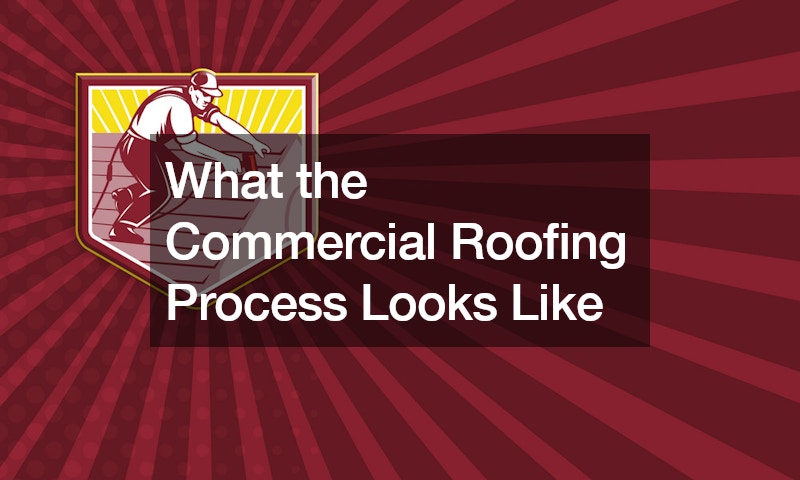
Replacing or repairing a commercial roof is a significant undertaking that requires careful planning, skilled labor, and adherence to safety protocols. Understanding the commercial roofing process can help property owners and managers prepare adequately and ensure a smooth project execution. Here’s a comprehensive overview of what to expect during the commercial roofing process:
Preparation and Setup
Before the project begins, communication with commercial roofing contractors is essential. They will arrange for the delivery of necessary materials and a dumpster for debris removal.
This preparation phase ensures that everything is in place before work commences, minimizing disruptions and delays.
On the scheduled day, the roofing team typically arrives early, often around 7:00 a.m. They start by unloading equipment and setting up ladders to access the roof safely. Safety is paramount, and the crew will tie off to secure themselves while working at heights.
The exterior of the building is prepared by hanging large tarps along the roof’s edge. These tarps serve a dual purpose: they catch debris during the shingle tear-off process and protect the building’s siding, garden beds, bushes, and decks from damage.
Removing the Existing Roofing Materials
Once the setup is complete, commercial roofing contractors use roof rakes to carefully remove the existing shingles or roofing materials. The process starts from the top and works downwards. As they reach the bottom, the tarps are removed, and a thorough cleanup begins to ensure that all debris is cleared.
With the old roofing materials removed, the roofing team inspects the integrity of the roof deck. They look for any signs of damage or rot and replace plywood or deck boards as needed. This step is crucial as it ensures a solid foundation for the new roofing system.
Installing Underlayment and Protective Measures
Next, the focus shifts to installing underlayments, which are foundational components of the roofing system. A leak barrier, also known as ice and water shield, is installed 6 feet up from the roof’s edge and around all penetrations like skylights and chimneys. This barrier provides added protection against water infiltration.
The rest of the roof deck is covered with synthetic roofing felt, which acts as a moisture barrier and enhances the durability of the roof. Commercial roofing contractors meticulously install these materials to ensure complete coverage and effective waterproofing.
For properties with specific needs like skylights, the roofing team may replace or upgrade them during this phase to ensure they integrate seamlessly with the new roofing system.
Shingle Installation and Finishing Touches
With the underlayment in place, commercial roofing contractors begin bringing shingles up to the roof. This is often facilitated by using equipment like a ladder hoist, which safely lifts materials to the desired height without damaging the building’s structure.
Metal drip edge is then installed along both the eaves and the rakes of the roof. This metal edge provides a secure perimeter and helps channel water away from the roof’s edges. Starter shingles are laid over the drip edge as the first layer of defense against wind-driven rain.
Main shingles are then installed over the starter shingles, beginning at the bottom left corner of each roof plane and progressing upwards. This meticulous process ensures a uniform and weather-resistant roof surface.
Special attention is given to flashing details around roof penetrations such as skylights, pipes, vents, and chimneys. Flashing helps create watertight seals and prevents moisture from entering vulnerable areas of the roof.
Final Steps and Cleanup
Once all shingles and flashing are in place, the roofing team installs ridge vents at the peak or ridge of the roof. These vents facilitate proper ventilation, which is crucial for maintaining the roof’s longevity and preventing moisture buildup.
Finally, hip and ridge caps are installed to provide a finished appearance and ensure all edges are securely sealed. Throughout the installation process, commercial roofing contractors maintain a clean worksite, picking up debris and using magnets to collect loose nails from the lawn and garden areas.
Upon completion, a thorough inspection is conducted to ensure that the roof meets quality standards and specifications. Property owners or managers are typically briefed on the work done and any maintenance recommendations.
The commercial roofing process involves several meticulous steps that culminate in a durable and weather-resistant roof. Partnering with experienced commercial roofing contractors ensures that the project is executed efficiently and with minimal disruption to business operations. By understanding each phase of the process—from preparation and tear-off to installation and finishing touches—property owners can confidently manage roofing projects and maintain the structural integrity of their buildings.
For businesses considering roof replacement or repair, investing in professional commercial roofing contractors ensures a reliable and long-lasting roofing solution tailored to their specific needs.
.


